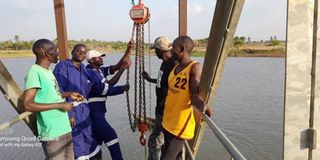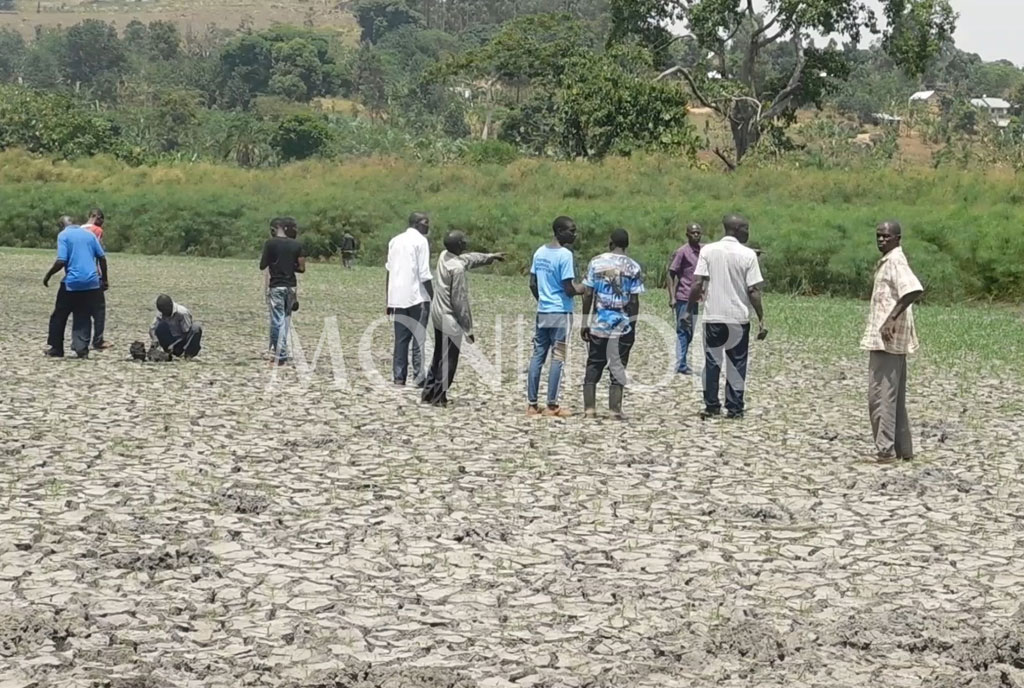Prime
NWSC starts rationing water in Gulu City over dry spell

National Water and Sewerage Corporation technical staff examine the Oitino Dam water levels last week. The dam’s water levels have drastically reduced due to a dry spell. PHOTO | NWSC
What you need to know:
- According to the notice, rationing tests have been conducted across the city to find out how to implement the programme and the schedule will be shared with our customers.
The National Water and Sewerage Corporation (NWSC) in Gulu City has resorted to rationing waterdue to the prolonged dry spell in the area.
Oitino dam has been one of the major water sources in the area but it is rapidly drying up.
Daily Monitor established that the dam’s water levels dropped to a record low at less than 2.5 metres deep, causing a significant drop in the volume of water to be pumped for supply.
At the weekend, the NWSC in a public notice stated that they were deeply concerned about the impact of the dry season on dam hence the need to ration the water.
“It has become necessary to ration water in the city as it will ensure that at least the whole city receives some water for limited hours daily to avoid situations where some areas go without water for days,” the statement reads in part.
According to the notice, rationing tests have been conducted across the city to find out how to implement the programme and the schedule will be shared with our customers.
The NWSC urged customers to store some water and use it sparingly through the period.
The corporation has divided the city into three zones to ration the water. Zone1 and Zone 2 will each be supplied for two days on a rationing basis, while Zone 3 areas will have supply for 12 hours every day.
Zone 1 includes areas such as Kabedopong, Laliya, Ariaga, Lawiyadul, St Mauritz, Keyi A&B, Bungatira, Laroo, Pageya, Ocer, Kasubi, Airfield and Layibi Techo, while Zone 2 has the town centre, Pece, Tegwana, Layibi centre, Koro, Rom, Vanguard, Pawel, and African Quarters.
Zone 3 includes Senior Quarters, Lacor centre, Cubu, Aywee, Onang, Nakasero, and Labourline.
Mr Ivan Tekakwo, the NWSC regional spokesperson, told this newspaper at the weekend that the decision will help them sustainably supply water to all areas.
“There are no other option now because the dam is drying up quickly. At peaks of rainfall, the dam would produce upward of 10 million litres of water per day but now it is producing only 3 million litres, far below the average capacity,” Mr Tekakwo said.
Whereas several motorised boreholes had been built in the past to supplement water produced from the dam, Mr Tekakwo said their production capacity has also dropped.
“The yields of the boreholes have also dropped to about 1.5 million litres down from the 2.1 million, litres it would give per a day. In total, the dam and the boreholes are now jointly producing a combined 4 million litres per day, less than half of the consumption capacity of the city.”
Background
Gulu City has frequently been experiencing intermittent water supply due to the unreliability of Oyitino dam. According to officials, billions of litres of water have been lost in the past weeks due to the drought. With the anticipated increase in demand in the Gulu water supply area with the acquisition of city status, the capacity of the dam and the six supplementary boreholes shall be far outstripped within a few years.The NWSC is, however, optimistic to stabilise and boost water supply capacity in the city once the construction of the recently launched Karuma-Gulu underground pipe water supply system is complete. Last month, government started works on the 72km underground piped water system to draw water from the River Nile at Karuma to Gulu City. Once complete, the plant will have an abstraction capacity of 30 million liters per day, and will supplement another 10 million litres per day to Gulu.




